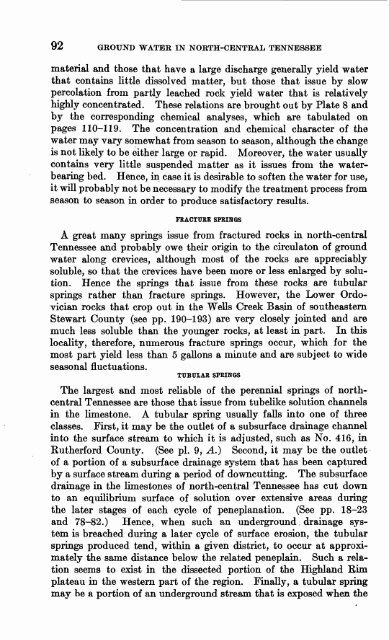GROUND WATER IN NORTH-CENTRAL TENNESSEE
GROUND WATER IN NORTH-CENTRAL TENNESSEE
GROUND WATER IN NORTH-CENTRAL TENNESSEE
Create successful ePaper yourself
Turn your PDF publications into a flip-book with our unique Google optimized e-Paper software.
92 <strong>GROUND</strong> <strong>WATER</strong> <strong>IN</strong> <strong>NORTH</strong>-<strong>CENTRAL</strong> <strong>TENNESSEE</strong><br />
material and those that have a large discharge generally yield water<br />
that contains little dissolved matter, but those that issue by slow<br />
percolation from partly leached rock yield water that is relatively<br />
highly concentrated. These relations are brought out by Plate 8 and<br />
by the corresponding chemical analyses, which are tabulated on<br />
pages 110-119. The concentration and chemical character of the<br />
water may vary somewhat from season to season, although the change<br />
is not likely to be either large or rapid. Moreover, the water usually<br />
contains very little suspended matter as it issues from the water<br />
bearing bed. Hence, in case it is desirable to soften the water for use,<br />
it will probably not be necessary to modify the treatment process from<br />
season to season in order to produce satisfactory results.<br />
FRACTURE SPR<strong>IN</strong>GS<br />
A great many springs issue from fractured rocks in north-central<br />
Tennessee and probably owe their origin to the circulaton of ground<br />
water along crevices, although most of the rocks are appreciably<br />
soluble, so that the crevices have been more or less enlarged by solu<br />
tion. Hence the springs that issue from these rocks are tubular<br />
springs rather than fracture springs. However, the Lower Ordo-<br />
vician rocks that crop out in the Wells Creek Basin of southeastern<br />
Stewart County (see pp. 190-193) are very closely jointed and are<br />
much less soluble than the younger rocks, at least in part. In this<br />
locality, therefore, numerous fracture springs occur, which for the<br />
most part yield less than 5 gallons a minute and are subject to wide<br />
seasonal fluctuations.<br />
TUBULAR SPR<strong>IN</strong>GS<br />
The largest and most reliable of the perennial springs of north-<br />
central Tennessee are those that issue from tubelike solution channels<br />
in the limestone. A tubular spring usually falls into one of three<br />
classes. First, it may be the outlet of a subsurface drainage channel<br />
into the surface stream to which it is adjusted, such as No. 416, in<br />
Rutherford County. (See pi. 9, A.) Second, it may be the outlet<br />
of a portion of a subsurface drainage system that has been captured<br />
by a surface stream during a period of downcutting. The subsurface<br />
drainage in the limestones of north-central Tennessee has cut down<br />
to an equilibrium surface of solution over extensive areas during<br />
the later stages of each cycle of peneplanation. (See pp. 18-23<br />
and 78-82.) Hence, when such an underground. drainage sys<br />
tem is breached during a later cycle of surface erosion, the tubular<br />
springs produced tend, within a given district, to occur at approxi<br />
mately the same distance below the related peneplain. Such a rela<br />
tion seems to exist in the dissected portion of the Highland Rim<br />
plateau in the western part of the region. Finally, a tubular spring<br />
may be a portion of an underground stream that is exposed when the

















